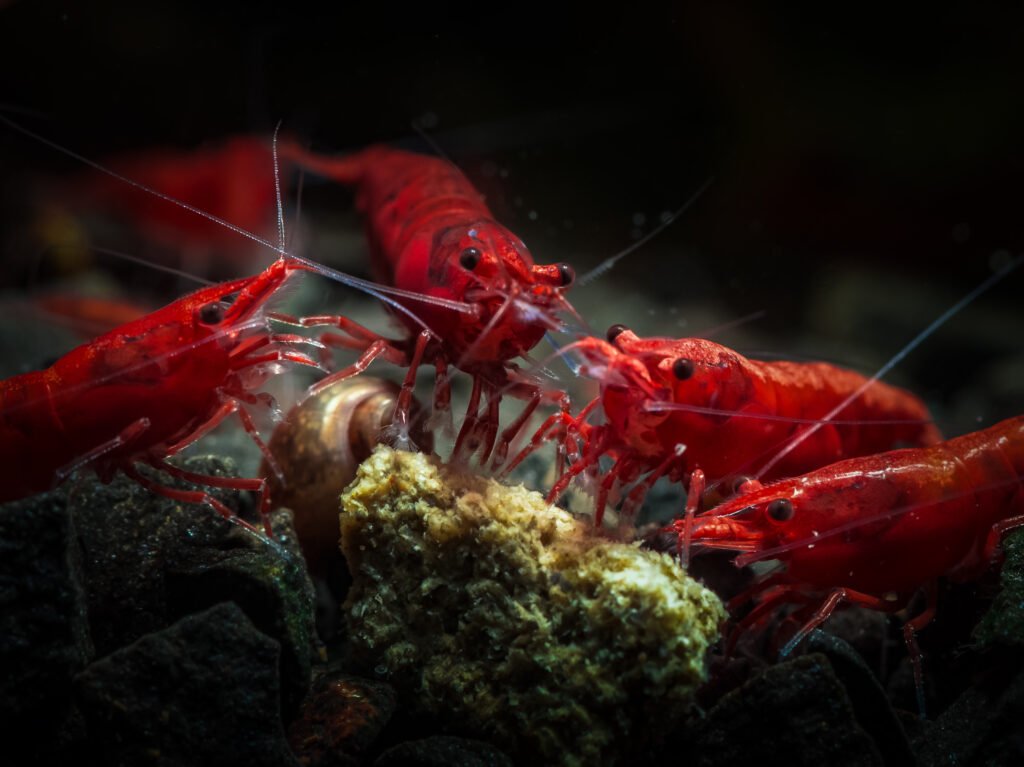Breeding shrimp can be a rewarding and fascinating aspect of the shrimp-keeping hobby. Watching a colony grow and thrive in your aquarium is a testament to your care and attention to detail. However, successful breeding requires understanding the needs of your shrimp and providing the right environment. This guide will walk you through the essential steps to breeding shrimp successfully.
.

Choosing the Right Shrimp Species
Not all shrimp species are equally easy to breed. Some are more challenging and require specific conditions, while others breed readily in most aquarium settings.
•Easiest Species: Neocaridina davidi (e.g., Red Cherry Shrimp) are among the easiest to breed and are perfect for beginners. They adapt well to a range of water conditions and breed prolifically.
•More Challenging Species: Caridina cantonensis (e.g., Crystal Red Shrimp) require more specific water parameters and are best suited for experienced hobbyists.
Setting Up the Breeding Tank
To increase the chances of successful breeding, it’s important to set up a dedicated breeding tank or ensure that your main tank meets all the necessary conditions.
•Tank Size: A 10-20 gallon tank is ideal for breeding shrimp, providing enough space for a growing colony without overwhelming the tank’s filtration system.
•Substrate: Use a fine-grain substrate that shrimp can easily sift through. Specialized shrimp substrates can help maintain stable pH and water parameters.
•Filtration: A sponge filter is recommended as it provides gentle filtration without the risk of harming baby shrimp (shrimplets). Sponge filters also promote biofilm growth, which is a natural food source for shrimp.
•Plants and Hiding Spots: Include plenty of live plants, mosses, and hiding spots. These provide cover for female shrimp carrying eggs and for shrimplets once they hatch.
Water Parameters for Breeding
Maintaining stable and optimal water conditions is crucial for breeding shrimp.
•Temperature: Most shrimp species breed best in temperatures between 22°C and 26°C (72°F to 79°F). Use a heater to maintain a stable temperature within this range.
•pH: For Neocaridina species, aim for a pH between 6.5 and 7.5. Caridina species may require a lower pH, around 6.0 to 6.5.
•Hardness: General Hardness (GH) should be maintained between 6-8 dGH, and Carbonate Hardness (kH) between 0-2 for most shrimp species. Soft water with low mineral content is preferred for many breeding shrimp.
•Nitrate Levels: Keep nitrate levels low, ideally below 20 ppm. Regular water changes are essential to maintaining water quality.
Encouraging Breeding Behavior
To encourage breeding, it’s important to provide the right conditions and nutrition.
•Diet: Feed a varied diet that includes high-quality shrimp pellets, blanched vegetables, and protein-rich foods like bloodworms or brine shrimp. Ensure that the diet is rich in minerals, especially calcium, to support healthy molting and egg development.
•Stable Environment: Avoid sudden changes in water parameters, temperature, or tank setup. Stability is key to reducing stress and encouraging natural breeding behaviors.
•Male-to-Female Ratio: Maintain a healthy ratio of males to females, typically 1:2 or 1:3, to ensure that females are not over-stressed by constant breeding attempts.
Caring for Pregnant Shrimp
When a female shrimp becomes pregnant (also known as being “berried”), she will carry eggs under her abdomen until they hatch.
•Observation: Keep an eye on berried females and ensure they have plenty of hiding spots. Stress can cause females to drop their eggs.
•Minimize Disturbance: Avoid moving or disturbing pregnant shrimp. If possible, reduce tank maintenance activities to minimize stress.
•Hatching Time: Depending on the species and temperature, eggs typically hatch within 2-4 weeks. The tiny shrimplets will remain hidden for a few days before venturing out.
Raising Shrimplets
Caring for baby shrimp is one of the most delicate aspects of shrimp breeding.
•Feeding: Baby shrimp feed on biofilm, algae, and microorganisms. Ensure that the tank has ample surfaces for biofilm to grow. You can also offer finely powdered shrimp food or specialized baby shrimp food.
•Protection: Provide plenty of hiding spots and ensure the tank has no predators. Even adult shrimp can sometimes pose a threat to shrimplets, so ample cover is essential.
•Water Quality: Keep water quality high with regular, small water changes. Avoid large changes that could shock the delicate shrimplets.
Common Challenges and How to Overcome Them
Breeding shrimp comes with its own set of challenges, but with the right knowledge, these can be managed effectively.
•Egg Loss: Sometimes, females drop their eggs due to stress, poor water conditions, or nutrient deficiencies. Ensure that water parameters are stable and that the diet is well-balanced to prevent this.
•Low Survival Rate: If shrimplets are not surviving, it could be due to predation, poor water quality, or lack of food. Ensure there are no predators in the tank, maintain high water quality, and provide adequate food sources.
•Unbalanced Male-to-Female Ratio: If females are not becoming berried, it might be due to an unbalanced male-to-female ratio or too few males. Adjust the ratio to encourage successful breeding.
Conclusion
Breeding shrimp successfully requires attention to detail and a commitment to maintaining stable, optimal conditions. By choosing the right species, setting up an appropriate environment, and providing proper care, you can enjoy the rewarding experience of watching your shrimp colony grow. With patience and dedication, breeding shrimp can become one of the most enjoyable aspects of shrimp-keeping.⬤